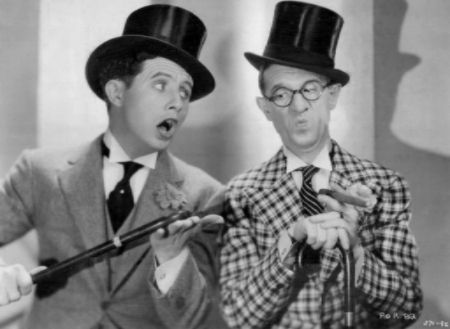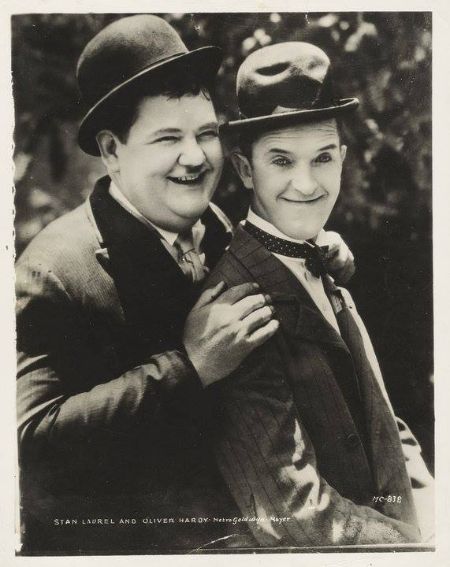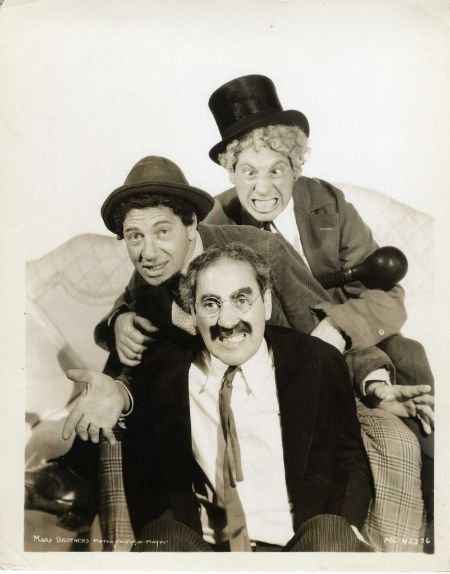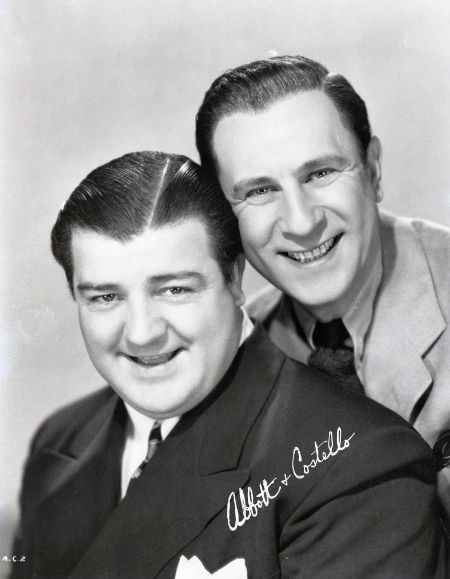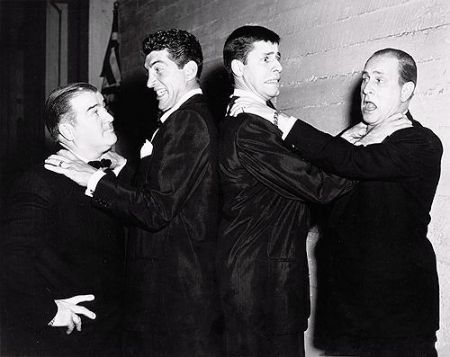They came from vaudeville and Broadway, from the silent cinema and radio, and later, the nightclubs. They are some of the most recognizable names in American screen comedy—names that are synonymous with Hollywood’s golden age. Laurel & Hardy… The Marx Brothers… Abbott & Costello…. Individual talents who, through destiny or chance, became united with partners just as talented. Legends were born, and they’ve entertained generations ever since. These are the faces of comedy. This is Legends of Laughter 2: The Comedy Teams.
This spring, the Park Ridge Public Library Classic Film Series returns for its eighth season with a series devoted to the movie comedy teams of the 1930s, ‘40s, and ‘50s. In addition to the most famous teams, the series will showcase the lesser-known comedy acts that managed to carve out a niche for themselves. Comics like Wheeler & Woolsey churned out vehicle after vehicle at RKO with their bawdy, vaudevillian sensibility and Pre-Code lunacy. And Olsen & Johnson, Universal’s other comedy act, were visually inventive, offering audiences deliriously surreal sight gags that were ahead of their time.
If there were ever two patron saints of comedy, it was Laurel & Hardy. To this day, they are universally recognized for the good cheer they’ve brought to millions and the almost magical ease with which they accomplished this onscreen. There was Ollie, the larger man with his “tie twiddle” and his exasperated stares into the camera; and Stanley, the smaller, more child-like man who would often cry while pulling up his hair. Stan & Ollie were a team built on the law of opposites with a strong, deep abiding love and affection for one other. It is this affection that always seemed to transcend the “nice messes” each put the other through. The warmth that these two characters felt for each other, and which we feel towards them, is a quality few other comedy teams possessed.
They were from opposite worlds. Stan Laurel was born Arthur Stanley Jefferson in Ulverston, Lancashire, England. He came from the English music hall tradition, traveling with the same troupe of stage performers that produced Charlie Chaplin. In fact, Stan Laurel had been Chaplin’s understudy in the Fred Karno troupe. After touring America in vaudeville, Stan made the U.S. his home and later became a writer and director for producer Hal Roach.
Oliver Hardy was born in the American South, in Harlem, Georgia. “Babe” Hardy could sing, but it was the call of the cinema that drew him to comedy. He appeared in many silent films, usually in support of other silent comics like Larry Semon. Eventually, Oliver Hardy, too, became part of Hal Roach’s stock company in the mid-1920s. In 1926, with the assistance of Hal Roach and director Leo McCarey, Mr. Laurel and Mr. Hardy were brought together and movie history was made.
Their slapstick was rooted in visual comedy. Their films did not always have the frantic pace of other comedies; their success rested in the timing and deliberate buildup of a gag. The timing is best displayed in their “tit-for-tat” routines which contained a high degree of destruction of personal property! Over the course of nearly a quarter century, the duo would appear in dozens of films, but the most polished were those made for Hal Roach.
Laurel & Hardy came together within the medium of film, but for the Marx Brothers, it was on the stage where the spotlight first shone…
They remain one of the most popular teams of all-time. They poked fun at everyone– and everything. They were the Marx Brothers: Groucho, the cigar-smoking ringleader with the greasepaint mustache; Harpo, the horn-honking, girl-chasing throwback to the silent world comics; Chico, the piano playing Italian who wasn’t really Italian; and Zeppo, the romantic straight man sometimes lost in the shuffle. Whether it’s a television marathon on New Year’s Eve or a screening during Legends of Laughter, their movies will always be revived. They remain a laughing tonic against life’s troubles.
The brothers were born in the closing decades of the 19th century and were already performing by the first decade of the 20th century. The sons of Jewish immigrants who lived in a poor section of New York’s Upper East Side, the Marx brothers became a family act that grew up in vaudeville. It was here, through trial and error, where they worked out their material and formed their classic personas. By the mid-1920s, they were stars on Broadway, excelling in musical comedy. Beginning in 1929 with The Cocoanuts, the Marx Brothers became movie stars. In their best films, the brothers were known for a type of anarchistic comedy in which institutions, authority figures, and even society matrons were mocked—usually by Groucho. The lines were often absurd, the situations, surreal. Their brand of lunacy hit its creative peak with 1933’s Duck Soup. Directed by Leo McCarey, the film utilized a variety of comedic forms –from satire and song to slapstick and pantomime. Their humor was predominantly in the dialogue– in Groucho’s puns and witty observations. For a medium learning how to talk, movies never had it so good.
But the Marx Brothers weren’t the only comics who made audiences laugh with clever verbal exchanges and rapid-fire dialogue. Nearly eighty years later, fans of classic comedy are still laughing at “Who’s On First?”
They did not sing. They did not dance. But in their films, Bud Abbot and Lou Costello were experts at what they did, whether it was those methodical word games or the timing of their lines. Bud and Lou never worked with Hal Roach or Leo McCarey, but their appeal rested in the stage routines where it didn’t matter who the director was; they didn’t need direction to make people laugh. In their films, Bud was usually the nattily-dressed fast-talker, and Lou, his child-like patsy who was easily confused. They were the most popular comedy team in the business until post-war America embraced a more unhinged style of comedy.
They were top ten box office champions throughout most of the 1940s, but they were equally successful on radio and later, television. William “Bud” Abbott, the greatest of all the straight men, came from a show business family. He had been a burlesque performer in the days when vaudeville had passed. Lou Costello had also performed in stock burlesque after first appearing in films as an extra and stunt double. Bud and Lou appeared together for the first time in 1936. It was during these years on the stage where they performed sketches they would further develop in motion pictures. By 1940, Universal Pictures had signed them to a contract, but it would be a year later before they would become major stars with the release of Buck Privates. Throughout the forties they starred in military service comedies and later, horror spoofs that extended their careers into the 1950s.
Legends of Laughter 2 will also showcase the team that succeeded Abbott & Costello in popularity: Martin & Lewis—the biggest comedy act of the 1950s and the first to skyrocket in the television age.
Legends of Laughter 2 runs from March 3 to May 26, 2016, at the Park Ridge Public Library. The screenings are free and begin at 7PM.
